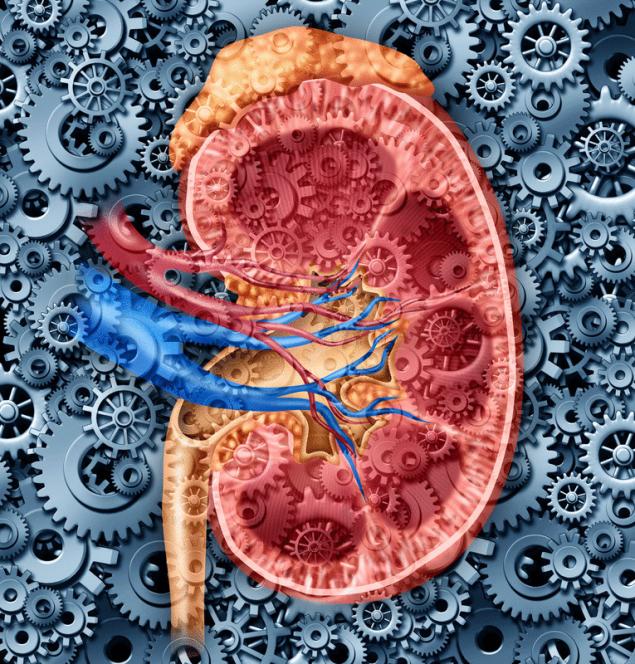471
New technology - drugs that dissolve kidney stones
Drugs to treat leukemia and epilepsy also drugs that dissolve kidney stones. 14.08.2014 g. Every patient with kidney stones knows that there is no solvent of kidney stones drugs. A new study on mice shows that a class of drugs approved to treat leukemia and epilepsy also may be effective for dissolving kidney stones.

Drugs-class a histone-deacetylase ingibitornoe study on mice showed that the class of drugs approved to treat leukemia and epilepsy also may be effective dissolving kidney stones. Drugs-class a histone-deacetylase inhibitors (or inhibitors HDAC) – Vorinostat and trichostatin – lower levels of calcium and magnesium in the urine. As you know, calcium and magnesium are the main components of kidney stones.
Scientists hope that this class of drugs can dissolve kidney stones. Because these drugs reduce the level of calcium and magnesium exclusively in the renal cells. Why are kidney stones? In most cases kidney stones are formed when urine becomes too concentrated. This leads to the formation of complex crystals of calcium and magnesium.
If the stones get stuck in the urinary tract and block the flow of urine, there is severe pain. Diet can promote or prevent the formation of kidney stones. If you do not drink enough water or eat too much salt, it promotes excretion of calcium with urine and thereby increase the risk of formation of kidney stones.
Some people also are genetically prone to develop kidney stones (which also contains a lot of calcium in the urine). As a rule, doctors recommend to drink plenty of water for removal of stones from kidneys and body. Thiazide diuretics used to treat high blood pressure, also sometimes prescribed for the treatment of kidney stones, because they reduce the content of calcium in the urine. But these drugs also increase the level of magnesium in the urine, which protivodeistviya efficiency for dissolving kidney stones.
Dissolve kidney stones drugs will affect preciousena showed that vorinostat (approved for the treatment of leukemia and epilepsy) and trichostatin A (an antifungal drug) mimic the natural process in the kidney, the consequences of which is the removal of calcium and magnesium in the urine. The kidneys filter waste from the blood in the urine, and also play an important role in the reabsorption of minerals that the body needs to perform basic vital functions.
Typically, some portion of calcium and magnesium filtered from the blood into the urine, and then is absorbed back into the bloodstream depending on the body's need for these important minerals. Scientists know that this process largely depends on the activity of a gene called Claudin-14. When the activity of Claudin-14 is stable, the filtering system of the kidneys working as it should. But when the gene is activated, is blocked absorbcia of calcium and magnesium. Expression of the gene Claudin-14 is controlled by two stretches of RNA.
In the new study, researchers found that vorinostat and trichostatin do not directly affect the gene Claudin-14 but mimic the action of micro-RNA molecules resulting in continued activity of the gene. The fact that these drugs can modify the activity of micro-RNAS, makes them attractive as a potential solvent for kidney stones treatment.
In mice, even small doses vorinostat reduced the level of calcium in the urine by more than 50 percent and magnesium levels by 40%. Similar results were observed for drug trichostatin A. the cells of the kidneys are very sensitive to the action of the drug. The scientists used only one-twentieth of the dose normally used in humans, and has achieved significant results.
Scientists plan to test the effectiveness of the solvent of the drug in clinical trials for patients with kidney stones. In mice there are no kidney stones, so it is important to check how these dissolving kidney stones the drugs are effective patients people. This study has shown that the drug class histone - deacetylase inhibitors (or inhibitors HDAC) regulate the same path, which leads to the formation of kidney stones.
Source: globalscience.ru

Drugs-class a histone-deacetylase ingibitornoe study on mice showed that the class of drugs approved to treat leukemia and epilepsy also may be effective dissolving kidney stones. Drugs-class a histone-deacetylase inhibitors (or inhibitors HDAC) – Vorinostat and trichostatin – lower levels of calcium and magnesium in the urine. As you know, calcium and magnesium are the main components of kidney stones.
Scientists hope that this class of drugs can dissolve kidney stones. Because these drugs reduce the level of calcium and magnesium exclusively in the renal cells. Why are kidney stones? In most cases kidney stones are formed when urine becomes too concentrated. This leads to the formation of complex crystals of calcium and magnesium.
If the stones get stuck in the urinary tract and block the flow of urine, there is severe pain. Diet can promote or prevent the formation of kidney stones. If you do not drink enough water or eat too much salt, it promotes excretion of calcium with urine and thereby increase the risk of formation of kidney stones.
Some people also are genetically prone to develop kidney stones (which also contains a lot of calcium in the urine). As a rule, doctors recommend to drink plenty of water for removal of stones from kidneys and body. Thiazide diuretics used to treat high blood pressure, also sometimes prescribed for the treatment of kidney stones, because they reduce the content of calcium in the urine. But these drugs also increase the level of magnesium in the urine, which protivodeistviya efficiency for dissolving kidney stones.
Dissolve kidney stones drugs will affect preciousena showed that vorinostat (approved for the treatment of leukemia and epilepsy) and trichostatin A (an antifungal drug) mimic the natural process in the kidney, the consequences of which is the removal of calcium and magnesium in the urine. The kidneys filter waste from the blood in the urine, and also play an important role in the reabsorption of minerals that the body needs to perform basic vital functions.
Typically, some portion of calcium and magnesium filtered from the blood into the urine, and then is absorbed back into the bloodstream depending on the body's need for these important minerals. Scientists know that this process largely depends on the activity of a gene called Claudin-14. When the activity of Claudin-14 is stable, the filtering system of the kidneys working as it should. But when the gene is activated, is blocked absorbcia of calcium and magnesium. Expression of the gene Claudin-14 is controlled by two stretches of RNA.
In the new study, researchers found that vorinostat and trichostatin do not directly affect the gene Claudin-14 but mimic the action of micro-RNA molecules resulting in continued activity of the gene. The fact that these drugs can modify the activity of micro-RNAS, makes them attractive as a potential solvent for kidney stones treatment.
In mice, even small doses vorinostat reduced the level of calcium in the urine by more than 50 percent and magnesium levels by 40%. Similar results were observed for drug trichostatin A. the cells of the kidneys are very sensitive to the action of the drug. The scientists used only one-twentieth of the dose normally used in humans, and has achieved significant results.
Scientists plan to test the effectiveness of the solvent of the drug in clinical trials for patients with kidney stones. In mice there are no kidney stones, so it is important to check how these dissolving kidney stones the drugs are effective patients people. This study has shown that the drug class histone - deacetylase inhibitors (or inhibitors HDAC) regulate the same path, which leads to the formation of kidney stones.
Source: globalscience.ru























